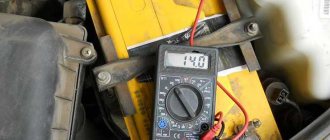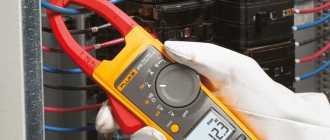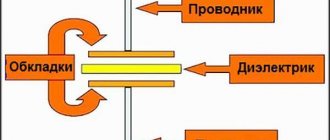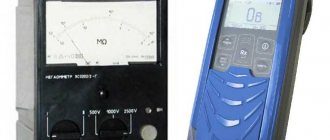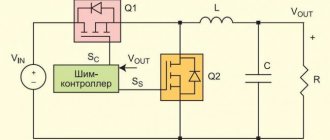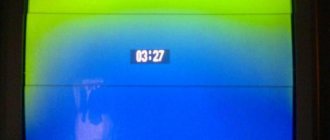Many devices operating from a 220 V network have a diode bridge installed. This is a device consisting of four (for a single-phase network) or six (for a three-phase) semiconductor silicon diodes. It is needed to convert alternating current to direct current. An alternating current is supplied to its input, and the output produces a pulsating voltage of constant sign. These circuit elements often fail, pulling the fuse along with them. Let's figure out how to check the diode bridge for serviceability in different ways.
How to ring a diode bridge made of discretely arranged diodes
All parts of the bridge circuit can be ringed without desoldering. To do this, you need a multimeter that has a diode testing mode, usually combined with an audio test. The essence of the test is to measure the voltage difference between the probes.
How to properly check the serviceability of a diode bridge with a tester:
- First, make a direct connection to the device. To do this, a red probe is connected to the anode, and a black probe is connected to the cathode. With this connection, current flows freely. For a silicon diode, the voltage drop across the pn junction is approximately 500-700 mV. For Schottky diodes, the voltage drop at the transition between zones is lower and equal to approximately 300 mV.
- Next, the reverse connection is made. The red probe is connected to the cathode, and the black one to the anode. For a healthy semiconductor, the voltage drop value will be 1 or more than 1000 (usually 1500).
Direct connection of the diode bridge
Reverse connection of the diode bridge
If, as a result of the test, high values are observed in both directions or an audible signal is triggered, then the diode bridge is broken.
Principle of operation
The operation of a diode semiconductor bridge that conducts current is simple. The principle of operation is based on the property that a semiconductor diode passes electric current in one direction and does not pass in the other. So, if the charges are connected correctly, current will flow through the device.
The difference between alternating current and direct current is that it can only move in one direction. Moreover, do this in one half-cycle. During the other half of the period, it can make the opposite movement. When several diodes are connected in a circuit, they will begin to move, creating a direct current.
It is easy to assemble a diode bridge circuit. Anyone can do this. It includes four diodes, which are connected to each other by a square. Current is supplied to several opposite corners from the generator apparatus. From several other opposite angles the constant is removed. During the first period, several electrodiodes are opened and the alternating voltage wave is rectified. In the second period, several more diodes are opened. Thus, the second wave is transformed. The result is a constant voltage with a pulse frequency several times higher than that with alternating voltage.
Interesting! The presented scheme has its pros and cons. To use rectified current, the pulse component must be smoothed with a filter. Thanks to rectification, it is possible to power the transformer and reduce its volume. Among the disadvantages, note the fact that power is lost due to thermal dissipation, the voltage drops twice and the device breaks down if one diode fails.
How the device works
How to check the diode bridge in a transformer power supply using a light bulb
For this method you will need an incandescent lamp with a power of up to 100 W, screwed into the socket. The lamp is connected to the break in the power phase wire. If a short circuit occurs on the board, then when the device is connected to the network, the fuse will blow, the wire itself will blow, or the circuit breakers will be knocked out. If you check using an incandescent light bulb, then such troubles can be avoided. If there is a short circuit, the light bulb connected to the network will light up brightly. It won't burn out because the resistance of the coil will limit the current. If the electronic components of the board are working properly, the light will not light up at all or a faint glow will be observed.
Diode bridge breakdown
If a malfunction is detected
Diodes are attached to the wafers by pressing into a hole of a smaller diameter, so replacing a faulty semiconductor yourself is a troublesome task that does not guarantee 100% success. Diode bridges for domestic cars are inexpensive, so if a fault is detected, it is replaced with a new one.
Rectifier units of modern foreign cars cost a lot of money, so replacing the diode in such a bridge is economically justified. It is better to entrust this procedure to a specialist.
The quality of operation of the entire electrical system of the car depends on the condition of the diode bridge. If the previously listed signs of malfunction appear, you must immediately diagnose, repair or replace it.
A simple check of the integrity of the diode bridge of the transformer power supply
If we found out using a light bulb that there are problems on the board, using an indicator screwdriver we can find out whether there is a break on the diode bridge. If the indicator lights up on the phase wire at the input to the rectifier, we carry out further checking. If the indicator does not light up, then the problem is not in the diode circuit, but in the power cable. The indicator checks the presence of voltage at the positive output of the rectifier. If it is present, then the diode bridge is not broken. We will not receive more information during such a check.
There is no breakdown of the diode bridge
Safety precautions
It is important to understand that almost all modern equipment has a switching high-voltage power supply. This means that the diode bridge in each device is under a three-hundred-volt voltage, as well as the AVBbShv power cable. For this reason, before taking measurements, it is necessary to turn off the device from the network and discharge the smoothing electrolytic capacitor, which contains a dangerous charge. To make this more clear, dangerous elements are marked in the figure with red arrows.
Dangerous equipment items
To discharge them, it is necessary to short-circuit the capacitor terminals using a screwdriver. It is important to hold the insulating handle while doing this. It is equally important not to rush to connect the power plug after making repairs. First, you need to connect the device to the network through an incandescent light bulb with a power of 200 watts. If properly repaired, the light bulb will produce a weak light. If the repair is unsuccessful, it will be bright and indicate that a short circuit may occur.
Note! When making all kinds of network switching, you need to protect your eyes. If the switching power supply is not properly repaired, its cells may explode, releasing acidic electrolytes.
In general, a diode bridge is a composite structure of many electrical elements. You can check it according to the instructions presented above using a tester, without installation and dialing. Naturally, it is necessary to carry out any work while observing safety precautions.
How to Accurately Test a Diode Assembly: Detailed Analysis
To check, you will need a multimeter that has a diode test mode.
Verification steps:
- Testing begins with diodes 1 and 2. To do this, the red probe of the tester is connected to the terminal with the “-” sign. Above the two center terminals there is an AC or ̴ marking. The black probe is connected in turn, first to one such terminal, and then to the second. This is a direct connection in which current flows freely. The display of the digital multimeter will show the voltage drop across the pn junction when connected directly. In foreign datasheets this value is designated as Vf. For silicon diodes it is in the range of 0.4-0.7 V. For Schottky semiconductors it is lower and equal to approximately 0.3 V. If these values are displayed on the measuring device, then the diode assembly is working.
- To clarify the results of checking diodes 1 and 2, a reverse connection is made. To do this, connect a black probe (negative) to the “-” terminal. The red probe is alternately connected to the terminals marked AC or ̴. The display should show a unit, indicating high resistance and no reverse current. If this is so, then the serviceability of diodes 1 and 2 is confirmed.
- Next, check the verification of diodes 3 and 4 under the condition of direct connection. To do this, connect the black probe to the positive, and the red one in turn is connected to the AC terminals. The display should display the voltage drop across the pn junction, which was described in detail in the first paragraph.
- To confirm the result, connect the red probe to the plus, and the black probe to the AC terminals. The display should show one.
If the diode assembly successfully passes this test, we can say with confidence that all elements are in good working order.
DM functions
If we recall the physics course from school, we will conclude that there are two types of electric current. It is constant and variable. How are they different from each other?
There's nothing complicated here. The key difference is that alternating current has charged particles that move in different directions. In the case of direct current, movement always occurs in only one direction.
I would like to note that alternating current has noticeably better economic characteristics. They cope more effectively with transmitting current over fairly long distances. The only problem is that most electrical appliances in vehicles are powered by direct current. In order for a vehicle to function properly, electrically dependent equipment must receive a certain amount of direct current. The generator itself cannot provide it, since it produces alternating current.
Our today's hero allows us to solve this problem. That is, a diode bridge. It looks like a pair of metal conductive plates. They contain diodes that act as semiconductors. They are installed in a certain sequence.
The DM allows current to pass, but the bridge sets one direction. That is, the straightening process occurs. Another nuance is that the bridge sets traffic in only one direction. Namely, from the generator to the on-board network.
The serviceability of the DM is not eternal. Periodically, the generator element fails
And it doesn't matter what kind of car you have. It could be:
- VAZ 2107;
- VAZ 2114;
- Toyota Corolla;
- Lada Priora;
- Nissan Qashqai;
- Daewoo Matiz;
- VAZ 2110;
- Mitsubishi Lancer;
- Ford Mondeo;
- UAZ Patriot;
- Hyundai Solaris, etc.
Regardless of the car, you can and should check the functionality of the device with your own hands. For these purposes, it is important to use a tester.
If you are not sure about the correctness of your actions, watch visual videos. Don’t rush to blame the bridge for everything. Without disassembling or unsoldering the diodes, first make sure that it is faulty.
This is interesting: How to check a car battery - capacity and charging
How to check a generator diode bridge
Generator diode bridge
The diode bridge of a car or motorcycle generator is designed to rectify the alternating current generated by the generator and produce direct current for charging the battery and other power consumers. A malfunction of the diode bridge leads to a complete disappearance or a significant decrease in the amount of current produced by the generator. The most accurate results can be obtained at a service station - on a bench using an oscilloscope.
One of the options for simple testing of semiconductors is a continuity test using a multimeter. However, this is an unreliable method, since the load on the device is very small, so the malfunction may not be detected.
To check the diode bridge of the generator under load, use a test light, this can be a regular 12 V car lamp.
The rectifier unit consists of two aluminum plates combined into a single structure. 3 diodes are soldered into each of them. Positive and negative diodes are soldered in pairs. Checking the bridge circuit for a short circuit (short circuit) between the plates is carried out in the following way:
- The positive wire from the lamp is connected to the top plate, and the negative wire to the bottom. If the light does not light up, then there is no short circuit.
- The polarity is changed. If there is no short circuit, the light comes on.
- Positive semiconductors are checked for breakdown and breakage by pressing the positive wire from the light bulb to the top plate. The negative is alternately connected to the connection points of the semiconductors. If the circuit is working properly, the light does not light up. When changing polarity, the light should light.
- Negative diodes are tested by pressing the negative wire to the bottom plate and the positive wire to the semiconductor connection points. If the circuit is working properly, the light bulb does not light up; when the polarity is changed, it should light up.
Why does the gene burn out?
There are many reasons leading to gene (diode) burnout. However, it is customary to highlight the most common:
- dirt or oil has penetrated into the bridge, causing a short circuit;
- on Japanese cars - due to a voltage drop when the generator wears out;
- due to the fault of the voltage regulator, which supplies the rotor, and that, accordingly, to the diode bridge;
- due to a “bad” battery (there are batteries that consume 40A and easily kill the gene);
- the gene was flooded with water;
- the standard fuse responsible for protecting the gene during short circuits has failed;
- The battery terminals were installed incorrectly.
Thus, the generator on the car burns out for various reasons. We are always talking about the combustion of the regulator and diode bridge. Everything is checked quickly based on superficial symptoms. If you need to be 100 percent sure, you have to disassemble the generator.
- Absolutely legal (Article 12.2);
- Hides from photo and video recording;
- Suitable for all cars;
- Works through the cigarette lighter connector;
- Does not cause interference to radios and cell phones.
Analogs
Silicon diode, diffusion, rectifier blocks intended for use in power supplies and rectifier devices of general-purpose equipment may be suitable for replacement.
Domestic production
| Type | URRM | URMS | UDC | IF(AV) | IFSM | Ta | RƟJA | U.F. | IR Ta=25°C | IR Ta=100°C | C.T. | Frame |
| MB10F | 1000 | 700 | 1000 | 0,5 | 25 | 150 | 85 | 1 | 5 | 500 | 13 | MBF (SMD) |
| KTs402A/Zh | 600 | — | — | 1 | — | 85 | — | 4 | — | 125 | — | — |
| KTs403A/Zh | 600 | — | — | 1 | — | 85 | — | 4 | — | 125 | — | — |
| KTs404A/Zh | 600 | — | — | 1 | — | 85 | — | 4 | — | 125 | — | — |
| KTs405A/Zh | 600 | — | — | 1 | — | 85 | — | 4 | — | 125 | — | — |
Foreign production
| Type | URRM | URMS | UDC | IF(AV) | IFSM | T.J. | RƟJA | U.F. | IR Ta=25°C | IR Ta=100°C | C.T. | Case, notes |
| MB10F | 1000 | 700 | 1000 | 0,5 | 25 | 150 | 85 | 1 | 5 | 500 | 13 | MBF (SMD) |
| DB107 | 1000 | 700 | 1000 | 1 | 50 | 150 | — | 1,1 | 10 | 500 | — | DB-1 (SMD) |
| DB107S | 1000 | 700 | 1000 | 1 | 50 | 125 | — | 1,1 | 10 | 500 | — | DB-1S (SMD) |
| DB157 | 1000 | 700 | 1000 | 1,5 | 60 | 150 | — | 1,1 | 5 | 500 | — | DB-1 (SMD) |
| DB157S | 1000 | 700 | 1000 | 1,5 | 60 | 150 | 40 | 1,1 | 5 | 500 | — | DB-S (SMD) |
| DF10 | 1000 | 700 | 1000 | 1 | 30 | 150 | 40 | 1,1 | 10 | 500 | 25 | DIL (SMD) |
| B10S | 1000 | 700 | 1000 | 0,8 | 30 | 150 | 85 | 1 | 5 | — | 25 | MDI (SMD) |
| B10S | 1000 | 700 | 1000 | 1 | 35 | 150 | — | 1 | 5 | 500 | — | MB-S (SMD) |
| B500S | 1000 | 500 | — | 1 | 40 | 150 | 60 | 1,1 | 10 | — | — | SO-DIL (SMD) |
| MS500 | 1000 | 500 | — | 0,5 | 20 | 150 | 70 | 1,2 | 10 | — | — | Micro-DIL (SMD) |
| B500C800 | 1200 | 500 | 1200 | 0,8 | 45 | 125 | — | 1 | 5 | 500 | — | WOB* |
| B500C1000 | 1200 | 500 | 1200 | 1 | 45 | 125 | — | 1 | 10 | 500 | — | WOB* |
| W10M | 1000 | 700 | 1000 | 1,5 | 40 | 125 | 36 | 1 | 10 | 500 | — | WOB* |
| W10L | 1000 | 700 | 1000 | 1,5 | 50 | 125 | — | 1 | 10 | 1000 | — | RC2* |
| W10G | 1000 | 700 | 1000 | 1,5 | 50 | 125 | 36 | 1 | 10 | 1000 | 24 | AM* |
| RB157 | 1000 | 700 | 1000 | 1,5 | 50 | 125 | — | 1 | 10 | 1000 | — | RB-15* |
| KBP10M | 1000 | 700 | 1000 | 1,5 | 50 | 150 | 28 | 1,1 | 10 | 500 | 15 | KBP* |
* — rod terminals.
Note: the data in the tables is taken from the datasheet of the manufacturing companies.
Diagnostic methods
As practice shows, diode bridges periodically fail on any vehicle, regardless of make and model
It is also not fundamentally important whether you use diode bridges from Valeo, Bosch or any other manufacturer
Most often, one or several diodes burn out in a DM. As for the reasons, here we can highlight:
- dust ingress;
- negative impact of dirt;
- contact of diodes with oil;
- accumulation of moisture in the generator;
- polarity error when lighting;
- incorrect battery connection;
- overload in the electrical network;
- errors in the installation of electrical equipment;
- factory defects, etc.
If you set a goal, the bridge can be checked in normal garage conditions. For such tasks, use a light bulb or a multimeter.


